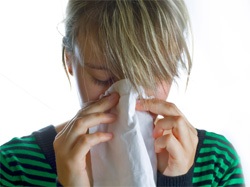Autonomic Function, HRV, in Seasonal Allergic Rhinitis
Kristen Sparrow • May 30, 2015

 This article looks at autonomic balance before and after a series of 12 acupuncture sessions. (Update: full article text here.)What they say is that the patients with Seasonal Allergic Rhinitis have a higher resting heart rate to start, and blunted cardiovascular response to cold pressor test. This is fascinating to me since one of the cases I’m studying in detail (discussed here and here) is a migraineur who has an exaggerated response to needling with a large spike in stress levels with needling and then profound drop. I have recent data from a patient with allergies, so I will at her data in more detail going forward. This gives me a different tack to take in looking at this detail. By the way, I’m not surprised that the sham worked as well as verum acupuncture in this case if the sham was actual needling.(Update 2: penetrating sham needling WAS used).
This article looks at autonomic balance before and after a series of 12 acupuncture sessions. (Update: full article text here.)What they say is that the patients with Seasonal Allergic Rhinitis have a higher resting heart rate to start, and blunted cardiovascular response to cold pressor test. This is fascinating to me since one of the cases I’m studying in detail (discussed here and here) is a migraineur who has an exaggerated response to needling with a large spike in stress levels with needling and then profound drop. I have recent data from a patient with allergies, so I will at her data in more detail going forward. This gives me a different tack to take in looking at this detail. By the way, I’m not surprised that the sham worked as well as verum acupuncture in this case if the sham was actual needling.(Update 2: penetrating sham needling WAS used).PATIENTS AND METHODS:
SAR patients (n = 30) were recruited from a larger randomized controlled trial investigating the efficacy of acupuncture in SAR. 21 patients received acupuncture, and 9 patients received sham acupuncture. Among other we measured resting heart rate variability and cardiovascular reactivity to a cold pressure test prior to and after 12 sessions of acupuncture or sham acupuncture. In addition, 30 age- and sex-matched healthy controls were tested once.
RESULTS:
SAR patients showed higher resting heart rate and lower heart rate variability as well as blunted cardiovascular responses compared to controls. After treatment, resting heart rate had decreased, and systolic blood pressure response to the cold pressure test had increased in SAR patients. We found no significant differences in autonomic function changes between patients receiving acupuncture or sham acupuncture.
CONCLUSION:
SAR patients showed alterations in autonomic function, which had partially normalized after treatment. However, in this sample we found no specific effect of acupuncture compared to sham acupuncture

